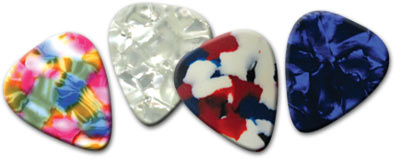- Continue Shopping
- Your Cart is Empty
History of Celluloid Guitar Picks
Celluloid is one of the most popular pick materials in the world today. It is perfect for printing on, making it ideal for Custom Printed Guitar Picks. Do you know the history behind Celluloids predecessor Tortoiseshell, and how Celluloid took over in popularity? Read on to find out...
Tortoiseshell

For thousands of years the plectrum has been used to play stringed instruments. Theories exist that perhaps the bow and arrow was the first stringed instrument and the arrowhead the first pick. Feather quills became widely used until the late 19th century. Then came what would become the superior plectrum material, the outer shell of the Atlantic Hawksbill Sea Turtle. This was referred to as 'Tortoiseshell'.
Tortoiseshell was the first patented guitar pick in the U.S. used to play an 8-string banjo/mandolin combo. This pick was designed by John Farris in 1885. Tortoiseshell provided the best combination of tonal sound and physical flexibility for plucking a taut string.
The practice of using hawksbill turtles for their shells became illegal in 1973, forcing musicians to find something else to pick with.
Even before the hawksbill turtle became protected, the high cost and difficulty of obtaining, heating and flattening the shell had people trying many other materials. Tortoiseshell was rare, expensive, and had a tendency to break.
Celluloid

Celluloid was the first commercial plastic and was invented by John Wesley Hyatt in 1870. Celluloid was discovered when the largest manufacturers of billiard balls offered a $10,000 reward for an acceptable substitute for ivory.
Celluloid is made from cellulose, one of the most abundant raw materials in the world, and nitrocellulose combined with camphor under heat and pressure produced celluloid. Celluloid is a combustible material and the first billiard balls would sometimes explode when hitting each other.
Tony D'Andrea was one of the first people to use celluloid to produce and sell guitar picks. In 1902 he came upon a sidewalk sale offering some sheets of tortoiseshell colored celluloid, eventually he discovered that the small pieces he punched out were perfect to pick stringed instruments with!
Celluloid's flexibility, durability, and inexpensiveness made it a perfect material for guitar picks. Celluloid became popular with guitarists because it very closely imitates the sound and flexibility of a Tortoiseshell guitar pick.
Source: Picks! by Will Hoover and Wikipedia
Leave a comment
Main Menu
Links
About Grover Allman
For over 25 years Grover Allman has been a world leader in guitar pick printing and design.
Grover Allman guitar picks and accessories are offered in music stores throughout the world. In addition to world-class guitar pick personalization, Grover Allman also offers a wide variety of guitar related products including custom guitar straps.
News & Updates
Sign up to get the latest on sales, new releases and more …
© 2024 Grover Allman.




